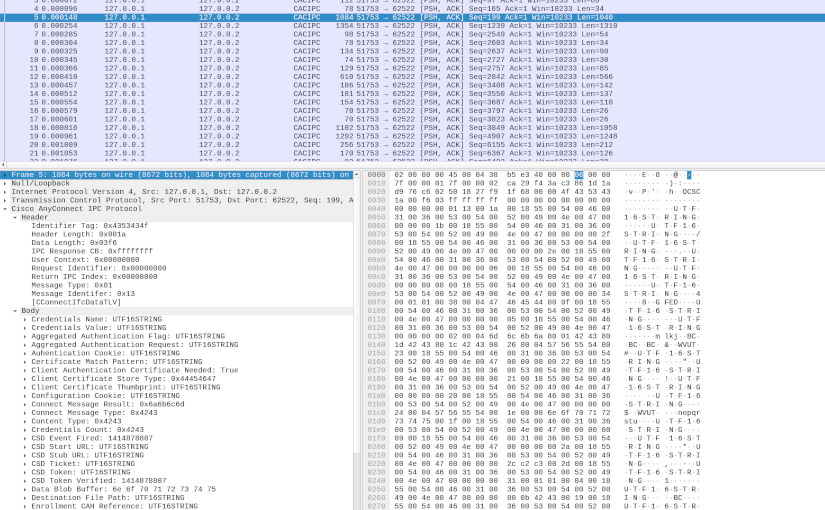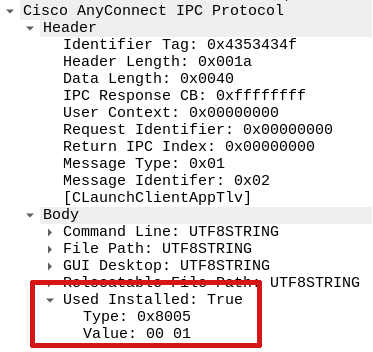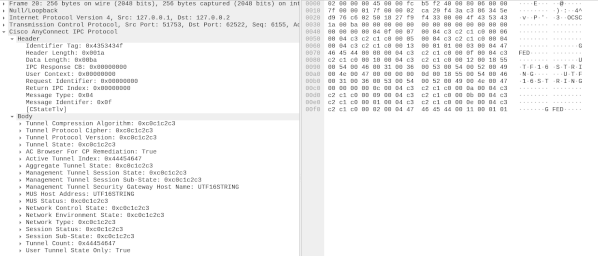
AnyConnect Inter-Process Communication
In my first deep dive into Cisco AnyConnect (CAC) Secure Mobility Client (see AnyConnect Elevation of Privileges Part 1 and Part 2), I reversed engineered how CAC made use of a TCP based Inter-Process Communication (IPC) protocol. Based on that research, I found a Local Privilege Escalation (LPE) vulnerability (see CVE-2016-9192 and the proof-of-concept code). Yorick Koster and Antoine Goichot followed suit, and using that research also found other vulnerabilities (see CVE-2020-3153, CVE-2020-3433, CVE-2020-3434, and CVE-2020-3435). This post presents the results of my second deep dive, correcting a wrong conclusion about the protocol, further reverse engineering the various IPC messages, and providing some tools that can potentially aid further research.
A Primer and Two Corrections
First, a small primer on how CAC communicates in between processes, namely vpnagent.exe, vpndownloader.exe, vpnui.exe, vpncli.exe, and potentially others. For example, the vpnagent.exe executable, when running starts listening at 127.0.0.1 on TCP port 62522. It’s on this port that it receives the various IPC messages sent by the other executables. The messages are based on a Type, Length, and Value (TLV) structure and have the following format:
1Header:
2 Identifier Tag: 0x4353434f # Fixed value of "CSCO".
3 Header Length: 0x001a # Header length, always 0x1A.
4 Data Length: 0x0000 # Varies depending on the body length.
5 IPC Response CB: 0x00000000 # Some messages require this value not to be null.
6 User Context: 0x00000000
7 Request Identifier: 0x00000000
8 Return IPC Index: 0x00000000
9 Message Type: 0x00 # Defines the type of message, this is in part how CAC distinguishes between messages.
10 Message Identifer: 0x00 # Defines the identifier of the message, this is the other part CAC uses to distinguish messages.
11Body:
12 # A list of TLVs...
This leads me to the wrong conclusion that I reached at the time. The body part of the IPC messages is basically a list of TLVs (if any). My assumption was that the Type part of each TLV, was composed of a native type (first byte), like string, integer, etc. and an index (second byte). However that is not the case, the full 2 bytes simply refer to the type in the context of the IPC message being sent, for example a file path, or an IP address. This means that the Type value may (and is) reused in various messages even if having a different native type. As such a TLV is composed of:
1A TLV:
2 Type: 0x0000 # Big endian 2 bytes unsigned integer
3 Length: 0x0000 # Big endian 2 bytes unsigned integer
4 Value: ... # Variable length
5
6A TV:
7 Type: 0x8000 # Big endian 2 bytes unsigned integer
8 Value: 0x0000 # 2 bytes long value
As seen above, there is another detail that I didn’t fully understand properly at the time and that contributed to the type/index confusion. The TLV type can have a modifier, if the type & 0x8000 == 0x8000 condition is true, then the entry in the body is no longer a TLV, but a Type and Value (TV) where the value always has 2 bytes length. The only usage I have seen for it, was for 2 bytes unsigned long integers, and boolean values as seen in the example below.
The Dissector
As part of this new deep dive, I have decided to create a Wireshark dissector that would allow one to easily understand captured IPC messages. The various messages, twenty six (26) in total, have been implemented, as well as all the fields.
The various fields can be used to filter the traffic. Follows some examples:
cacipc.message_typecacipc.state.tunnel_statecacipc.certificateinfo.cert_auth_signature_base64cacipc.userauthentication.user_accepted_banner_result
The dissector tries to match all the TCP packets sent on port 62522, and it makes use of an heuristic to find potential IPC messages not exchanged on that port. For example, vpndownloader.exe is sometimes launched listening for IPC messages on a random TCP port. In such cases, the dissector should detect any messages exchanged and dissect the traffic as CAC’s IPC.
vpncommon.dll. There are other IPC messages, namely the ones used when communicating with vpndownloader.exe that haven’t been implemented. This is something that may be fixed in the future.Packet Generator
While developing the dissector, I started to wonder how I could validate the dissection of the various messages. No packet capture I could create by just using CAC would have all the possible messages. As such, I decided to develop a packet generator. My first approach was to create a library (as in a .lib file) for the vpncommon.dll. That was the easy part, just a bit of dumpbin magic and that’s it, well mostly it.
The hard part was creating headers for each class, where the virtual address table properly matched the compiled version. After some failed attempts, I decided it was best to dynamically link against vpncommon.dll instead of statically linking. After many wrapper classes and some basic networking code had been developed, I had a shiny new packet generator that could generate all the implemented IPC messages.
There are some caveats though. To use the IPC packet generator, one needs to have CAC installed as the utility requires the vpncommon.dll library to generate the messages. I cannot, or better, should not distribute this DLL (or any other that may be needed) as it would most likely violate the license agreement (yes, that one that everyone, including me, just scrolls through). The other is that the packets generated are syntactically correct, but for sure aren’t semantically correct. For example, there might be TLV entries, that cannot be present in the same message with other TLV entries even if the message supports them, etc.
Closing Thoughts
More information about the dissector and the packet generator can be found here. I sincerely hope this will be useful to anyone that embarks in a journey to further investigate Cisco AnyConnect :D


